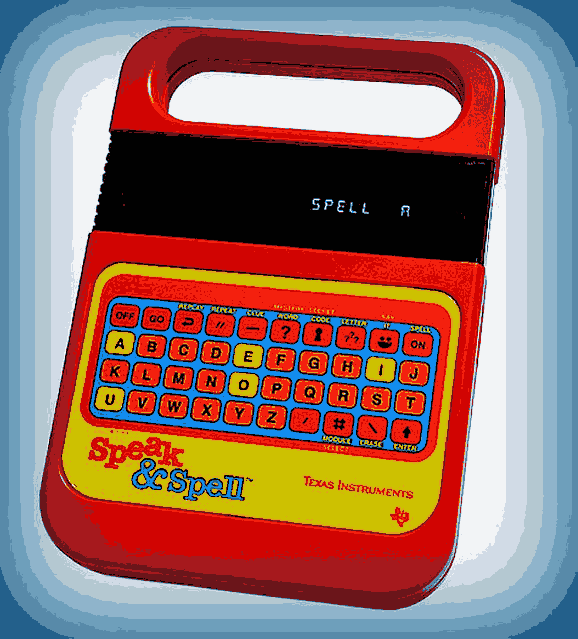There is no argument that the United States Military is the most powerful military in the World. We have achieved a level of technology in military weapons and equipment that no other nation on earth comes close to. So, what weapons and equipment is available to our military service members in times of war and conflict? This series will describe some of the main weapons and equipment items used by our members. It would take a very large book to thoroughly discuss all of the weapons and equipment used by the United States Military today, and I won't even try. This series will try to cover the highlights, starting with some of the main weapons and equipment used by the Infantry and Special Operations Units. In future parts of this series, I'll cover military vehicles, including tanks and armor, missiles and artillery, military aircraft, and military ships and submarines. Small Arms The basics of basics are the small arms weapons used by the individual infantryman. Here are the basic small arms used by the United States Army:  M16A2 Rifle. The M16A2 is the standard issue rifle. It's carried by pretty much every soldier in a combat zone. Most people simply call it the M-16. The M-16 has been around in one version or another since the Vietnam war (the first version, the M16A1 entered Army service in 1964). It's longevity is creditable to its usefulness as a general assault weapon. It's quite simply one of the finest military rifles ever made (although advocates of the M-4 Carbine may argue with me). The rifle is lightweight, simple to operate, and puts out a lot of lead. M16A2 Rifle. The M16A2 is the standard issue rifle. It's carried by pretty much every soldier in a combat zone. Most people simply call it the M-16. The M-16 has been around in one version or another since the Vietnam war (the first version, the M16A1 entered Army service in 1964). It's longevity is creditable to its usefulness as a general assault weapon. It's quite simply one of the finest military rifles ever made (although advocates of the M-4 Carbine may argue with me). The rifle is lightweight, simple to operate, and puts out a lot of lead.The M16A2 5.56mm rifle is a lightweight, air-cooled, gas-operated, magazine-fed, shoulder or hip-fired weapon designed for either automatic fire (3-round bursts) or semiautomatic fire (single shot) through the use of a selector lever. The weapon has a fully adjustable rear sight. The bottom of the trigger guard opens to provide access to the trigger while wearing winter mittens. The upper receiver/barrel assembly has a fully adjustable rear sight and a compensator which helps keep the muzzle down during firing. The steel bolt group and barrel extension are designed with locking lugs which lock the bolt group to the barrel extension allowing the rifle to have a lightweight aluminum receiver. Primary function: Infantry weapon Manufacturer: Colt Manufacturing and Fabrique Nationale Manufacturing Inc. Length: 39.63 inches (100.66 centimeters) Weight, with 30 round magazine: 8.79 pounds (3.99 kilograms) Bore diameter: 5.56mm (.233 inches) Maximum effective range: Area target: 2,624.8 feet (800 meters) Point target: 1,804.5 feet (550 meters) Muzzle velocity: 2,800 feet (853 meters) per second Rate of fire: Cyclic: 800 rounds per minute Sustained: 12-15 rounds per minute Semiautomatic: 45 rounds per minute Burst: 90 rounds per minute Magazine capacity: 30 rounds Unit Replacement Cost: $586 M-4 Carbine The M-4 combat assault rifle first entered Army service in 1997. The rifle is the standard weapon used by some Army units such as the 82nd Airborne Division and special operations units, such as Army Rangers.  With a shortened barrel and collapsible stock, the M-4 is ideal for close quarter marksmanship where light weight and quick action are required. Firing a standard 5.56 millimeter round, the weapon weighs a mere 5.6 lbs. (empty). A revised rear sight allows for better control of the weapon out to the maximum range of the ammunition used. With the PAQ-4 (Infrared Sight) mounted on the forward rail system, the M-4 can be fitted for increased firepower. With a shortened barrel and collapsible stock, the M-4 is ideal for close quarter marksmanship where light weight and quick action are required. Firing a standard 5.56 millimeter round, the weapon weighs a mere 5.6 lbs. (empty). A revised rear sight allows for better control of the weapon out to the maximum range of the ammunition used. With the PAQ-4 (Infrared Sight) mounted on the forward rail system, the M-4 can be fitted for increased firepower.The M-4 Carbine can also be fitted with the M-203 40mm grenade launcher. The M-203 is a lightweight, compact, breech loading, pump action, single shot launcher. The launcher consists of a hand guard and sight assembly with an adjustable metallic folding, short-range blade sight assembly, and an aluminum receiver assembly which houses the barrel latch, barrel stop and firing mechanism. The launcher is capable of firing a variety of low velocity 40mm ammunition. The launcher also has a quadrant sight that may be attached to the M-4 carrying handle and is used when precision is required out to the maximum effective range of the weapon. The M-4 in this photograph also has an M-68 close-quarters battle sight mounted on the rear rail and a PAQ-4 infra-red sight on the forward rail. Type: Compact assault rifle Entered Army Service: 1997 Specifications: Caliber: 5.56mm Weight: 5.65 lbs Range: 500 m Rate of fire: variable, depending on rate selected M-24 Sniper Weapon  The M24 Sniper's Weapon System (SWS) represents a return to bolt action sniper rifles by the US Army. The rifle entered Army service in 1998. The M24 uses the Remington 700 action, although the receiver has been made for adaptation to take the .300 Winchester Magnum round. The stock (HS Precision) is made of a composite of Kevlar, graphite and fiberglass bound together with epoxy resins, and features aluminum bedding block and adjustable butt plate. A detachable bipod (Harris) can be attached to the stock's fore-end. The M24 Sniper's Weapon System (SWS) represents a return to bolt action sniper rifles by the US Army. The rifle entered Army service in 1998. The M24 uses the Remington 700 action, although the receiver has been made for adaptation to take the .300 Winchester Magnum round. The stock (HS Precision) is made of a composite of Kevlar, graphite and fiberglass bound together with epoxy resins, and features aluminum bedding block and adjustable butt plate. A detachable bipod (Harris) can be attached to the stock's fore-end.The rifle is a bolt-action, six-shot repeating rifle (one round in the chamber and five rounds in the magazine). It is used with either the M3A telescope (day optic sight, usually called the M3A scope, a 10X fixed Leupold M3 Ultra telescope) or the metallic iron sight. This is the sniper weapon used by the Army. Caliber: 7.62x51mm NATO (.308 win) Operation: Bolt Action Feed: 5-Round internal magazine Weight: 12.1 lb (5.49 kg) empty without telescope Length: 43in (1092mm) Sights: 10x42 Leupold Ultra M3A telescope sight (Mil-Dots), plus detachable emergency iron sights. (Redfield Palma International) Barrel: 24" length, 1 twist in 11.2", 5 lands & grooves. Stock: HS Precision - adjustable length. Max Effective Range: 800 meters (875 yards) Expected Accuracy: 1 MOA with M118 (Ammo is limiting factor) M40A1 Sniper Rifle  This is the preferred sniper rifle for the U.S. Marine Corps. The M40A1 sniper rifle is based on the Remington model 700. It is a heavy barrel, bolt action, magazine fed 7.62mm rifle that is optimized for accuracy with Match Grade ammunition. The rifle is equipped with a special 10 power Unertl sniper scope. With scope, the rifle weighs approximately 14.5 pounds. It is equipped with a built-in five round magazine. This is the preferred sniper rifle for the U.S. Marine Corps. The M40A1 sniper rifle is based on the Remington model 700. It is a heavy barrel, bolt action, magazine fed 7.62mm rifle that is optimized for accuracy with Match Grade ammunition. The rifle is equipped with a special 10 power Unertl sniper scope. With scope, the rifle weighs approximately 14.5 pounds. It is equipped with a built-in five round magazine.The unique characteristics of the M40A1 Sniper Rifle are: commercial competition-grade heavy barrel, McMillan fiberglass stock and butt pad, modified Winchester Model 70 floor plate and trigger guard, and modified and lightened trigger. In addition, each stock is epoxy bedded for accuracy and all weapons must shoot less than one minute of angle (MOA). The M40A1 was put into service in the 1970s to meet the need of a long range sniper rifle. Each rifle is hand built by specially trained and qualified personnel at the Marine Corps Marksmanship Training Unit (MTU) at Quantico, Virginia. Length: 44 inches (111.76 centimeters) Barrel length: 24 inches (61 centimeters) Weight: 14.5 pounds (6.58 kilograms) Bore diameter: 7.62mm (.308 inches) Maximum effective range: 1000 yards (914 meters) Muzzle velocity: 2550 feet (777 meters) per second Chamber pressure: 50,000 psi Magazine capacity: 5 rounds Unit Replacement Cost: $2,105 M-249 SAW  The M-249 is unofficially called the Minimi. The official name for the weapon is SAW which means Squad Automatic Weapon. Early test versions of the M-249 were plagued with problems, but the current model is considered reliable. The weapon entered Army service in 1987, replacing the M-60 Machine Gun. The M-249 is unofficially called the Minimi. The official name for the weapon is SAW which means Squad Automatic Weapon. Early test versions of the M-249 were plagued with problems, but the current model is considered reliable. The weapon entered Army service in 1987, replacing the M-60 Machine Gun.The M-249 is a .223 cal (5.56mm) gas operated light weight machine gun which feeds from a belt held in a 100 or 200 rounds box under the gun. This weapon has a plastic pistol grip and a folding stock so it can be kept compact and light. The M-249 machine gun is an ideal complementary weapon system for the infantry squad platoon. It is light enough to be carried and operated by one man, and can be fired from the hip in an assault, even when loaded with a 200-round ammunition box. The barrel change facility ensures that it can continue to fire for long periods. The US Army has conducted strenuous trials on the M249, showing that this weapon has a reliability factor that is well above that of most other small arms weapon systems. The weapon is used by the U.S. Army and the U.S. Marine Corps. Type: Squad automatic weapon Entered service: 1987 Specifications: Caliber: 5.56mm Length:100 cm Weight:16.3 lbs Range: 800 meters Rate of fire: 750 rounds per minute M-240 Machine Gun  The M-240 entered Army and Marine Corps service in 1997. The M-240 is a version of FN's MAG 58 general-purpose machine gun. The M-240 fires the 7.62mm NATO round and is very reliable, with an estimated 26,000 Mean Rounds Between Failure (MRBF). The M-240 entered Army and Marine Corps service in 1997. The M-240 is a version of FN's MAG 58 general-purpose machine gun. The M-240 fires the 7.62mm NATO round and is very reliable, with an estimated 26,000 Mean Rounds Between Failure (MRBF).Advantages of this weapon include its popularity with other nation's forces and number of configurations. For example, in a helicopter crash, the M-240d helicopter-mount version could be quickly modified by installing the bipod and butt stock of the M-240b version, which would then allow the weapon to be used for self defense by the surviving helicopter crew members. The M-240 is manufactured in the following configurations: M-240b is designed for infantry use. The "B" version weapon is equipped with a thermal shield over the rear of the barrel to protect the operator. The M-240c version is designed for use internally in M2/M3 Bradley Infantry Fighting Vehicle. The M-240d is designed for use on pintel mounts in helicopters and on the outside of tanks and armored vehicles. The M-240g version is used by special operations forces. The heat shield on this version is removed and there are special fittings for night sights. Type: Medium machine gun Entered service: 1997 Specifications: Caliber: 7.62mm Weight: 27.6 lbs Range: 1,100 m Rate of fire: 600-9 rounds per minute |
SO WHAT!?
Monday, October 17, 2011
United States Military Weapons of War Part 1: Weapons and Equipment of the Infantry and Special Ops
Monday, September 5, 2011
10 Nostalgic Electronic Toys
Kids today might be used to various electronic toys and gadgets, but electronic toys are hardly new. There are plenty of retro electronic toys out there, and some are even making a comeback. They might not be as advanced as some more modern electronic toys but when growing up, they were every bit as fun.
From nostalgic video game systems to electronic dolls and stuffed animals, let’s take a look at ten retro toys that came before today’s electronic playthings. They’re listed in alphabetical order.
1. Atari
The Atari is one of the original video game systems that ultimately led to the popular consoles you know and love today. I still play some of these old games through emulators on my PC. What’s your favorite old Atari game?
2. Gameboy
The original Gameboy was Nintendo’s first handheld video game system. Looking at it now, it’s hard to believe we used to think of that as advanced game technology.
3. Glo Worm
Glo Worms were popular dolls in the 1980s. When you squeeze them they light up and play a lullaby. There was also a Glo Friends TV show.
4. Lite Brite
This simple but clever toy involves a light board that you put pegs into. You can put a black pattern sheet on top of the board that tells you which color pegs go where. It lets kids create lit works of art.
5. My First Sony
My First Sony was a precursor to modern day mp3 players. For many kids, this sturdy cassette player was their first portable music player.
6. NES
Who could forget the original Nintendo Entertainment System? It brought us video game classics like Super Mario Brothers and Zelda, which continue to thrive with new releases on newer video game systems.
7. Simon
This was one of the more popular electronic toys back in the day, modeled after the game Simon Says. The goal is to tap the colored lights in the correct succession after a pattern is played for you.
8. Speak and Spell
This educational toy let kids insert different cartridges to learn about spelling or play spelling-related games (similar to hangman). It was originally released in the late 1970s, but I remember playing this while growing up in the 1980s.
9. Star Projector
Another retro toy was the star projector. There were several different brands available (and even more advanced models today), allowing kids to enjoy a home-based version of a planetarium.
10. Teddy Ruxpin
Teddy Ruxpin was one of the first animatronic toys around — a toy bear that could tell stories to kids. The image below is of a more recent version released when Teddy Ruxpin made a comeback. The original used cassette tapes to play different stories.
These retro electronic toys might not be as advanced as some of today’s gadgets, but you can’t deny that many of them were fun. And some were so loved that they’ve seen a resurgence in recent years.
Do you have any favorite electronic toys from when you were a kid? Share your favorite electronic retro toys in the comments below.
article by:Jennifer Mattern
Tuesday, August 9, 2011
Monday, August 1, 2011
South Korean scientists create glowing dog - report
SEOUL (Reuters) - South Korean scientists said on Wednesday they have created a glowing dog using a cloning technique that could help find cures for human diseases such as Alzheimer's and Parkinson's, Yonhap news agency reported.
 A research team from Seoul National University (SNU) said thegenetically modified female beagle, named Tegon and born in 2009, has been found to glow fluorescent green under ultraviolet light if given a doxycycline antibiotic, the report said.
A research team from Seoul National University (SNU) said thegenetically modified female beagle, named Tegon and born in 2009, has been found to glow fluorescent green under ultraviolet light if given a doxycycline antibiotic, the report said.The researchers, who completed a two-year test, said the ability to glow can be turned on or off by adding a drug to the dog's food.
"The creation of Tegon opens new horizons since the gene injected to make the dog glow can be substituted with genes that trigger fatal human diseases," the news agency quoted lead researcher Lee Byeong-chun as saying.
He said the dog was created using the somatic cell nuclear transfer technology that the university team used to make the world's first cloned dog, Snuppy, in 2005.
The scientist said that because there are 268 illnesses that humans and dogs have in common, creating dogs that artificially show such symptoms could aid treatment methods for diseases that afflict humans.
The latest discovery published in 'Genesis', an international journal, took four years of research with roughly 3.2 billion won ($3 million) spent to make the dog and conduct the necessary verification tests, Yonhap said.
Sunday, July 31, 2011
Review: "Another Earth" is a thoughtful sci-fi romance
LOS ANGELES (TheWrap) - Can't bear to sit through yet another robot or superhero-filled extravaganza or R-rated raunchy comedy this summer? "Another Earth" offers the discerning moviegoer a welcome alternative.
This indie drama -- a prizewinner at this year's Sundance Film Festival -- is a sci-fi romance. But there's not a single alien in sight. Rather, the movie's all-too-human characters are more than a little alienated from their own feelings at times, trying their best to push down and mask painful emotions.
It's about exactly what the title says: a second Earth, complete with its own moon, has suddenly appeared. It hangs, shimmering on the horizon, visible from our Earth day and night and tantalizing all with its possibilities.
This other Earth first appears on the very night that a smart high-school senior, Rhoda Williams(played by newcomer Brit Marling, who co-wrote the script with first-time feature director Mike Cahill), is out celebrating getting accepted by M.I.T. Driving home after a night of partying, she runs a light and slams into a car carrying respected composer John Borroughs (William Mapother), his pregnant wife and young son.
When Rhoda gets out of prison a few years later, she seeks out John, the only one in his family to have survived the accident. She and John are both mere shells of their former selves, cut off from others emotionally by the after-effects of the tragedy. Without revealing her true identity, she inserts herself into his life. Slowly, these two help each other to begin to return to the land of the living.
Throughout the movie, there's constant talk on the radio and on TV about the other Earth and plans to journey there. Shades of TV's "Fringe": Could it be that everyone on our Earth has a doppelganger on the second Earth, an identical twin to yourself who just might be a happier and more successful version of you? It's a question of special appeal to both Rhoda and John.
Marling is a rangy blond with a long face that is just this side of interesting rather than being blandly beautiful. There is a muted intensity to her performance, which is all the more hauntingly effective for its restraint, especially as Rhoda begins to shed her emotional numbness.
It's a measure of "Another Earth's" ability to move a viewer that when you come out of the movie, you'll find yourself gazing upward, checking almost hopefully to see whether a second Earth hasn't made an appearance.
10,000 fans attend RI's Newport Folk Festival
 |
| David Wax performs with his band David Wax Museum at the Newport Folk Festival in Newport, R.I., on Sunday, July 31, 2011. (AP Photo/Joe Giblin) |
NEWPORT, R.I. (AP) — Blue skies and strong ticket sales blessed this year's Newport Folk Festival, two days of veteran acts and up-and-comers from a variety of musical genres.
An estimated 10,000 people attended the long-running festivalSunday at Fort Adams State Park, and they were treated to performances from Emmylou Harris, Elvis Costello, Wanda Jackson and more than a dozen other acts on three stages set around Newport's historic fort.
Hundreds more fans listened from sailboats, kayaks and rafts just offshore.
"We've been trying to get here for 40 years," said Terry Reese, of Fallbrook, Calif., who attended the festival with her husband, Donn, to celebrate their 36th wedding anniversary. "We wanted to hear real music, music that's not canned or packaged."
The festival, first held in 1959 and known as the place where Bob Dylan went electric in 1965, sold out in advance for the first time this year. Festival creator George Wein decided earlier in the year to make the folk festival — and its sister, the Newport Jazz Festival— non-profit in an effort to ensure their long-term survival.
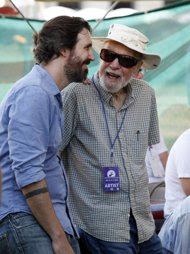 |
| Pete Seeger, right, talks backstage with his grandson Tao Rodriguez-Seeger at the Newport Folk Festival in Newport, R.I., Sunday, July 31, 2011. |
The event's mix of musicians from country, rock, blues and independent genres pleased festival-goer Jason Rosenstein, of Tiverton, R.I. He said that while the festival could rely on only older, established acts, it successfully injects a more youthful spirit by including many younger, up-and-coming bands.
"There's a lot of connecting going on, younger bands, older bands, different genres," he said. "It's a very positive energy."
It was a sentiment echoed by musicians including Taylor Goldsmith, of the band Middle Brother. Goldsmith said theNewport festival is his favorite festival for performing. The waterfront venue, with views of Newport's harbor, is one reason. The crowd and the lineup are others, he said.
"It's less about the festival, less about the acting crazy and more about the music," Goldsmith said.
Harris performed the final set of this year's festival, which began Saturday. Harris said she remembered hearing about the festival when she was a high school student listening to albums by Dylan, who was cheered by fans as an acoustic folk singer at the 1963 and '64 events but was jeered when he performed with an electric guitar in '65.
"I knew there was something going on out here, and there still is," Harris told the audience.
As an encore, folk pioneer Pete Seeger took the stage alongside Harris and several other musicians to lead the audience in singing two classics, "Turn! Turn! Turn!" and "Where Have All the Flowers Gone?"
The Newport Jazz Festival kicks off Friday at the same site.
Friday, July 29, 2011
Top United States Army Special Operations Conflicts
The United States Army special operations community is comprised of four main combat elements: Delta Force, Green Berets (Special Forces), Rangers and Nightstalkers (Special Operations Aviation Regiment or SOAR). In the past thirty years, these units have participated in conflicts around the globe.
 On April 24, 1980, elements of Delta Force and 1st Ranger Battalion set out to rescue 53 Americans who had been taken hostage at the American embassy in Iran.
On April 24, 1980, elements of Delta Force and 1st Ranger Battalion set out to rescue 53 Americans who had been taken hostage at the American embassy in Iran.
With mechanical issues with three helicopters, the mission was aborted.
Shortly after the order was issued to abort, another helicopter crashed into a C-130 causing eight casualties.
The mission was a failure and the hostages remained in Iran until the following January.
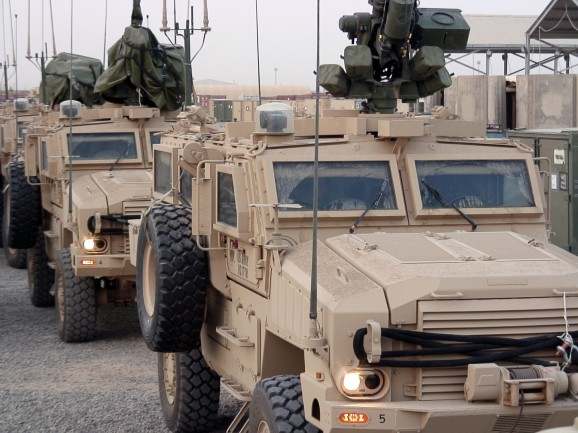 On October 25, 1983, Delta Force, 1st Ranger Battalion and 2nd Ranger Battalion invaded Grenada to protect American citizens and assist in restoring order to the island nation.A great portion of the forces had to unexpectedly jump into the combat zone while the rest were inserted by fast roping out of Blackhawk helicopters.
On October 25, 1983, Delta Force, 1st Ranger Battalion and 2nd Ranger Battalion invaded Grenada to protect American citizens and assist in restoring order to the island nation.A great portion of the forces had to unexpectedly jump into the combat zone while the rest were inserted by fast roping out of Blackhawk helicopters.
The mission was a success though highly criticized by other nations including Canada, Russia and Britain.
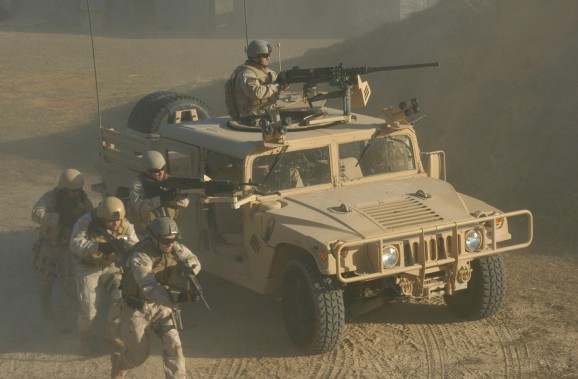 On December 20, 1989, Delta Force, Special Forces and all three Ranger Battalions were tasked with taking down the PDF and capturing General Noriega in Panama so he could be charged with drug smuggling.
On December 20, 1989, Delta Force, Special Forces and all three Ranger Battalions were tasked with taking down the PDF and capturing General Noriega in Panama so he could be charged with drug smuggling.
They seized the airfield and the surrounding areas under heavy gun fire from the PDF. Even with 23 American casualties, the mission was a success and ended on December 27th.
Noriega surrendered on his own to face the charges against him.
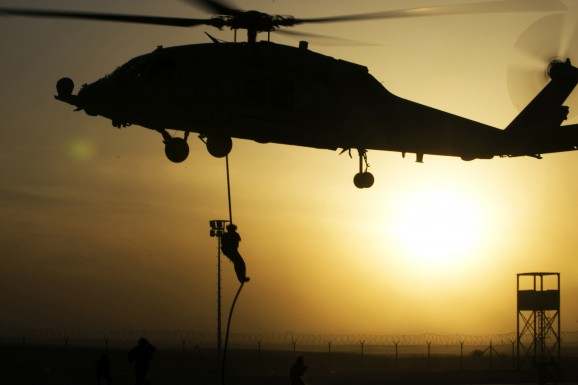 In 1993, the UN Ambassador to Somalia requested assistance in removing Mohamed Farrah Aidid from power in the country.
In 1993, the UN Ambassador to Somalia requested assistance in removing Mohamed Farrah Aidid from power in the country.
The United States deployed elements of Delta Force, 3rd Ranger Battalion and Nightstalkers to accomplish the task.
The elements entered the country in August but the real mission took place on October 3rd when intelligence indicated Aidid would be meeting with two of his top lieutenants.
The mission was going as planned until the opposition took down a Blackhawk helicopter that was circling the area. Some of the teams were redirected to the downed helicopter. Shortly after, a second helicopter was hit. Known for never leaving a fallen comrade, the special operations teams worked their way to secure the bodies in the two helicopters.
The pilot of the second helicopter had his body dragged through the streets and was held hostage for eleven days before eventually being released. When October 4th arrived, the Americans had suffered nineteen casualties and endured the worst fighting in recent history ultimately resulting in a failed mission.
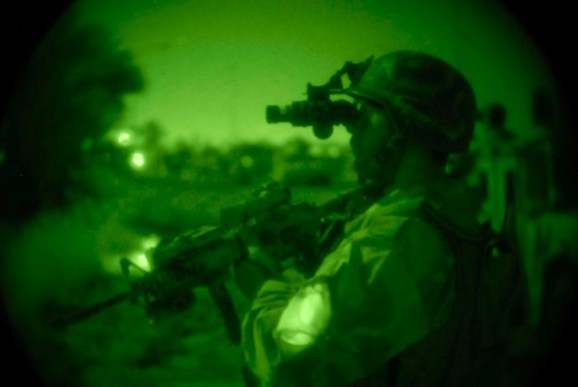 On March 4, 2002, a Navy SEAL fell from a helicopter that was fired on by Al Qaeda in Afghanistan. Rangers from 1st Battalion were flown by Nightstalkers to rescue the fallen SEAL.
On March 4, 2002, a Navy SEAL fell from a helicopter that was fired on by Al Qaeda in Afghanistan. Rangers from 1st Battalion were flown by Nightstalkers to rescue the fallen SEAL.
With communication issues, the Rangers were unaware they were landing in a hot zone and immediately came under heavy fire. The troops were able to secure the mountain top. Whether the mission was a success depends on who is asked.
Arguing between high-ranking officers led to the communication issues and played a part in the American deaths that occurred. It is also widely believed that high ranking Al Qaeda officers, including possibly Bin Laden, were able to escape during the battle.
All photos courtesy of USASOC.
Operation Eagle Claw (Desert One): Iran
 On April 24, 1980, elements of Delta Force and 1st Ranger Battalion set out to rescue 53 Americans who had been taken hostage at the American embassy in Iran.
On April 24, 1980, elements of Delta Force and 1st Ranger Battalion set out to rescue 53 Americans who had been taken hostage at the American embassy in Iran.With mechanical issues with three helicopters, the mission was aborted.
Shortly after the order was issued to abort, another helicopter crashed into a C-130 causing eight casualties.
The mission was a failure and the hostages remained in Iran until the following January.
Operation Urgent Fury: Grenada
 On October 25, 1983, Delta Force, 1st Ranger Battalion and 2nd Ranger Battalion invaded Grenada to protect American citizens and assist in restoring order to the island nation.
On October 25, 1983, Delta Force, 1st Ranger Battalion and 2nd Ranger Battalion invaded Grenada to protect American citizens and assist in restoring order to the island nation.The mission was a success though highly criticized by other nations including Canada, Russia and Britain.
Operation Just Cause: Panama
 On December 20, 1989, Delta Force, Special Forces and all three Ranger Battalions were tasked with taking down the PDF and capturing General Noriega in Panama so he could be charged with drug smuggling.
On December 20, 1989, Delta Force, Special Forces and all three Ranger Battalions were tasked with taking down the PDF and capturing General Noriega in Panama so he could be charged with drug smuggling.They seized the airfield and the surrounding areas under heavy gun fire from the PDF. Even with 23 American casualties, the mission was a success and ended on December 27th.
Noriega surrendered on his own to face the charges against him.
Task Force Ranger: Somalia
 In 1993, the UN Ambassador to Somalia requested assistance in removing Mohamed Farrah Aidid from power in the country.
In 1993, the UN Ambassador to Somalia requested assistance in removing Mohamed Farrah Aidid from power in the country.The United States deployed elements of Delta Force, 3rd Ranger Battalion and Nightstalkers to accomplish the task.
The elements entered the country in August but the real mission took place on October 3rd when intelligence indicated Aidid would be meeting with two of his top lieutenants.
The mission was going as planned until the opposition took down a Blackhawk helicopter that was circling the area. Some of the teams were redirected to the downed helicopter. Shortly after, a second helicopter was hit. Known for never leaving a fallen comrade, the special operations teams worked their way to secure the bodies in the two helicopters.
The pilot of the second helicopter had his body dragged through the streets and was held hostage for eleven days before eventually being released. When October 4th arrived, the Americans had suffered nineteen casualties and endured the worst fighting in recent history ultimately resulting in a failed mission.
Battle of Takur Ghar: Afghanistan
 On March 4, 2002, a Navy SEAL fell from a helicopter that was fired on by Al Qaeda in Afghanistan. Rangers from 1st Battalion were flown by Nightstalkers to rescue the fallen SEAL.
On March 4, 2002, a Navy SEAL fell from a helicopter that was fired on by Al Qaeda in Afghanistan. Rangers from 1st Battalion were flown by Nightstalkers to rescue the fallen SEAL.With communication issues, the Rangers were unaware they were landing in a hot zone and immediately came under heavy fire. The troops were able to secure the mountain top. Whether the mission was a success depends on who is asked.
Arguing between high-ranking officers led to the communication issues and played a part in the American deaths that occurred. It is also widely believed that high ranking Al Qaeda officers, including possibly Bin Laden, were able to escape during the battle.
All photos courtesy of USASOC.
Subscribe to:
Comments (Atom)







